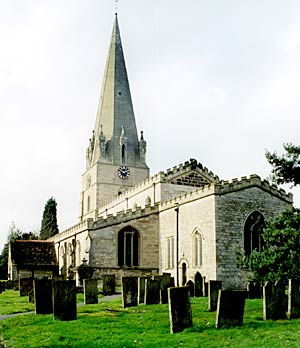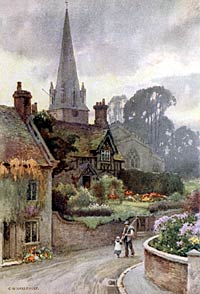Edwinstowe church
BY Mr Harry Gill

Edwinstowe church.
Legend and romance are closely interwoven with the early history of the king's great manor of Mansfield, and especially with this outlying “berewick,” which for centuries past has borne the name of Edwinstowe—a name which carries the mind back to the Saxon Heptarchy.
Eadwine, the first christian King of Northumbria, having fought and conquered the heathen princedoms, “became supreme over Britain as no king of English blood had been before.” (J. R. Green.)
From “Eadwines-burgh,” on the Firth of Forth, to the southern seaboard, the eastern side of the realm, all, save the men of Kent, acknowledged his sway.
Penda, the displaced King of the Mercian Angles, in alliance with Ceadwalla, King of Wales, strove to recover his lost supremacy, and in the fight which ensued (in A.D. 633), Eadwine was defeated and slain.
From the scanty records contained in the writings of the Venerable Bede, we learn that the king was slain at “Hoethfeld,” and that his head was sent to York for burial in the Church of St. Peter, which he was building."
The Church of St. Peter at York was a stone building, enclosing the little wooden church wherein Edwin had been baptized (A.D. 627) by Paulinus, Bishop of Northumbria. In after years the existing Cathedral Church of York was erected upon the same site.
“Hoethfeld,” or Hatfield, was an ancient name for a clearing in a forest, and there are many places in England to which it was applied. Perhaps the best known instances are Hatfield, in Herts., and the royal hunting ground known as Hatfield Chase, which lies partly within this county, at the extreme northern point of it, and whereon, we learn from the Venerable Bede, King Edwyn had built a hunting lodge and a church.
The “lodge,” or manor, was revived in the 14th century by Edward Ill., and continued in use until the waste land was drained, in the reign of Charles II. It was there that Queen Philippa gave birth to her second son, who was surnamed “de Hatfield.”
It is not surprising, therefore, that tradition has associated Hatfield, near Doncaster, with the site of the famous battlefield.
But when we remember that the name “Edwinstowe” was probably derived from "the sepulchre of Edwin; “that another Hatfield—i.e. Hatfield “above Warsop,”—lies within a very short distance of Edwinstowe; that at a very early date—so early that the origin is lost in antiquity—a royal hermitage and chantry was built midway between Edwinstowe and Warsop, dedicated to St. Edwin (a dedication quite unique), we have reasonable grounds for the suggestion that the memorable battle was fought in this neighbourhood, and that the Church of Edwinstowe was built over the spot where the headless body of the fallen king was buried.1
The words of the Rev. Abraham De la Prynne, Incumbent of Thorne, who wrote late in the 17th century, would be almost as applicable to this site as they were to Doncaster:

Edwinstowe view in 1910.
“The next day, when that the army was marcht away, several of the country round about that fled to save themselves from the heat & fury of the enemy, came to view the slain, & found them to amount to above 10,000; among the rest they found the body of poor King Edwin all plaistered over with Dirt, Blood, & Gore: whose head they cut off and sent it to York to some of his Nobles there that buryd it with great sorrow in St Peter’s Church which he was then building. As for his body, & that of his son Osfrid and the rest of his nobles, they were cast in a great Hole all together, and a large hill of earth thrown over them, which hill remains to this day in Hadham field, near the Lings, called now Sley-burr Hill, that is the hill where the slayn were buried.”
Of the early christian Church at Edwinstowe we know nothing, save that Domesday Book testifies to its existence in 1066—“in the time of King Edward there was a Church; and a priest at Edenestou …”
About a century after Domesday Survey was made—probably during the long and peaceful reign of Henry II,, of whom a contemporary did write: “a huge lover of woods is he, & when he ceaseth of war he haunteth places of hawking & hunting,”—when Sherwood Forest had become the royal hunting ground of the Angevins, and while the king was still in a mood to propitiate the murder of Becket by church building,2 the Saxon church, which in a forest district like this would surely have been constructed with oak posts on a stone foundation, gave place to a pretentious stone-built church as being more becoming on the demesne of a king, and this church was dedicated in honour of “St. Marie.”
In spite of frequent reparation, and notwithstanding the fact that during the reign of Charles 11. (circa 1672), “the Body of the Church was extremely shaken, & in a very ruinous condition,” occasioned by the fall of the spire, which “was beaten down by thunder,” some of the work of this period has survived until the present day.
The tower from plinth to cornice (not including the spire), the nave arcade on the north side, the lower portion of the chancel walls (including the priest's doorway, which has been re-set), together with several detached fragments to be referred to later, are the work of the Transitional period. The great antiquity of these stones will be impressed upon our minds when we think that it is far from impossible or improbable that the Angevin kings, yea, and even the bold Robin Hood may have entered within these hallowed walls, for if there be any foundation for the legend that the “gentlest thief that ever was,”3 brought his fair and comely bride, Maid Marian, from her home at Blidworth to “St Marie at Edwinstowe,” to receive the benison of holy church upon their wooing, the romantic event must have taken place when the church, of which these stones formed an integral part, was fresh from the hand of the builders (circa 1180). All the authorities agree that the wonderful deeds of the bold outlaw were chiefly wrought during the last decade of the 12th century; and the reputed meeting between king and outlaw at Clipstone must have taken place when Richard Coeur-de-Lion paid his first and only visit to Sherwood Forest, in 1194.
Although documentary evidences concerning the genesis of the church are few and scanty, we are able to trace the evolution of the plan of the church, with a fair degree of certainty, from indications on the stones.
When we take into consideration the roof lines, which are still visible on the eastern face of the tower; the quoin stones in the wall below, and the style and general character of the workmanship, it seems clear that the church was originally planned with a long nave and short chancel, much on the same lines as we see it now, but without side aisles or clerestory. If we may judge by the “straight joint” between the tower wall and the arcade on the north side; and by the omission of one small member from the head mould of the corbel to the tower arch, when it runs on as a string course until it becomes the abacus of the western respond, a narrow aisle was thrown out on this side, either before the building was quite finished or very shortly afterwards. A south aisle and clerestory were added a century and a half later; the addition of a spire to complete the steeple, and the widening of the north aisle was carried out after the lapse of another century.
This suggestion is strengthened by comparison with other forest churches in the district, especially those included in our programme to-day. Sookholme and Carburton are still aisleless. Cuckney has a narrow aisle on the north side only. Warsop is almost identical in plan with Edwinstowe, while the similarity in the mouldings of the older portion of the work leaves little room for doubt that the two churches were built under the same influence.
(1) A monk of Whitby tells how the body was ultimately translated thither and buried in the monastery, but the accuracy of these early documents is open to question.
(2) Henry's formal pardon from Rome was issued 1172.
(3) W. Camden.
